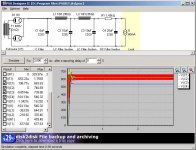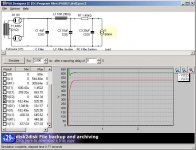hi all
i've acquired 2 rca83s for rectification duties on a future amp project, much against the advice from diyers of my local audio forum.
i would like to use them to power a lower voltage drd 300b. my speakers are 86db efficient, and i borrowed a diy-ed 300b (AN Quest design) to test my speakers with them. they sounded great, and with enough bass for me. 😉
to allow the heaters to warm up first, the 83 would have a switch on the 0 winding of the main trans to switch the B+ supply (manually switched).
besides the precautions listed in this thread, are there any other that i should look out for?
i read some datasheets that suggested a max of 4uF as input capacitor filter and 450-0-450 main trans. but at Josh Stippich's site, he had a diy design that is using 10uF input cap and 480-0-480 main trans. Sakuma also used a large input cap in some of his designs. anyone can comment on this input cap value or has experience with the 83?
i've ran some simulations using psud2. the RC filter at the far right reduces the overshoot in voltages when starting, not sure if i should include this. also, what is the normal dc rating of a 400vac motor run cap?
this is what i intend to use:
forgot to add that the voltage at C3 is 630vdc.
i've acquired 2 rca83s for rectification duties on a future amp project, much against the advice from diyers of my local audio forum.
i would like to use them to power a lower voltage drd 300b. my speakers are 86db efficient, and i borrowed a diy-ed 300b (AN Quest design) to test my speakers with them. they sounded great, and with enough bass for me. 😉
to allow the heaters to warm up first, the 83 would have a switch on the 0 winding of the main trans to switch the B+ supply (manually switched).
besides the precautions listed in this thread, are there any other that i should look out for?
i read some datasheets that suggested a max of 4uF as input capacitor filter and 450-0-450 main trans. but at Josh Stippich's site, he had a diy design that is using 10uF input cap and 480-0-480 main trans. Sakuma also used a large input cap in some of his designs. anyone can comment on this input cap value or has experience with the 83?
i've ran some simulations using psud2. the RC filter at the far right reduces the overshoot in voltages when starting, not sure if i should include this. also, what is the normal dc rating of a 400vac motor run cap?
this is what i intend to use:
forgot to add that the voltage at C3 is 630vdc.
Attachments
The GE spec sheet says 40 uf max on the cap input. I've been using 20uf as the first cap downstream from a pair of 83s in a FW rectifier configuration. They don't break a sweat. I used two, as they're driving a stereo push-pull 300Bs, each idling at 65ma (so 260ma total idle, a bit over the top of the 225ma max). As has been said, when first firing them up from the box, let the filaments heat for 30 minutes to completely vaporize the mercury. I do the 30 minute deal again whenever I move the tubes. During regular use, I have a time delay relay that waits 30 seconds before grounding the center tap. If you have seperate filament trans for the 83's, the TDR can have easier duty by switching the HT primary trans instead of the secondary.
If you're curious, I posted a picture and schematics on a speaker thread here:
300B amp on Alpha LS speaker thread
Gary
If you're curious, I posted a picture and schematics on a speaker thread here:
300B amp on Alpha LS speaker thread
Gary
I once accidentally fired up a used 83 with a 100mA load, with no warm up whatsoever, first time it had probably been used in decades, after rattling around in my car. It just glowed the normal white-blue, no problems. I think these things are pretty much indestructible. Although I think the mercury strips the cathode coatings over time, both used ones I found had areas with no glow...
OT: Wow, what an amp! GaryW, got any more pics of that monster? Did the 83s need any RF snubbers? BTW Love the speakers too!
OT: Wow, what an amp! GaryW, got any more pics of that monster? Did the 83s need any RF snubbers? BTW Love the speakers too!
You may have gotten away with something, as these rectifiers will definitely arc over if the mercury is not vaporized. I was demo'ing at VSAC a couple years back - blew the fuse and the 83. That's why I always do the 30 minute warmup after moving the tubes now...
I'll see if I can dig up a few more pic's of the amp. I had some construction pics, but that was a couple operating system refresh cycles ago...
I'll see if I can dig up a few more pic's of the amp. I had some construction pics, but that was a couple operating system refresh cycles ago...
- Status
- Not open for further replies.

